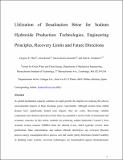Utilization of Desalination Brine for Sodium Hydroxide Production: Technologies, Engineering Principles, Recovery Limits and Future Directions
Author(s)
Thiel, Gregory Parker; Kumar, Amit; Lienhard, John H.
DownloadThiel_ACS_2017.pdf (15.26Mb)
Terms of use
Metadata
Show full item recordAbstract
As global desalination capacity continues its rapid growth, the impetus for reducing the adverse environmental impacts of brine discharge grows concurrently. Although modern brine outfall designs have significantly limited such impacts, they are costly. Recovering valuable components and chemical derivatives from brine has potential to resolve both environmental and economic concerns. In this article, methods for producing sodium hydroxide (“caustic”) from seawater reverse osmosis (SWRO) brine for internal reuse, which typically involve brine purification, brine concentration, and sodium chloride electrolysis, are reviewed. Because process energy consumption drives process cost and caustic purity determines product usability in drinking water systems, reviewed technologies are benchmarked against thermodynamic minimum energy consumption and maximum (stoichiometric) NaOH production rates. After individual reviews of brine purification, concentration, and electrolysis technologies, five existing facilities for caustic production from seawater and seawater concentrates are discussed. Bipolar membrane electrodialysis appears to have the best potential to meet the technoeconomic requirements of small-scale caustic production from SWRO brine. Finally, future research and demonstration needs, to bring the technology to commercial feasibility, are identified.
Date issued
2017-11Department
Massachusetts Institute of Technology. Department of Mechanical EngineeringJournal
ACS Sustainable Chemistry and Engineering
Publisher
American Chemical Society
Citation
Thiel, Gregory P., Amit Kumar, Alicia Gómez-González, John H. Lienhard, V. "Utilization of Desalination Brine for Sodium Hydroxide Production: Technologies, Engineering Principles, Recovery Limits and Future Directions." ACS Sustainable Chemistry and Engineering 5, 12 (November 2017):11147-11162.
Version: Author's final manuscript
ISSN
2168-0485